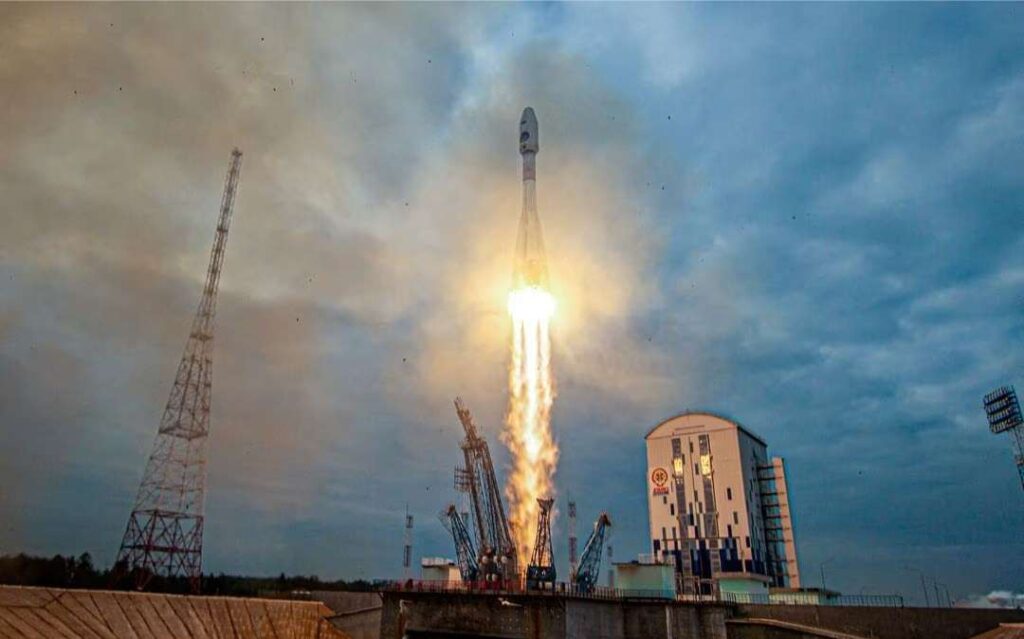Russia’s first lunar mission Luna-25 met with an unfortunate end as it crashed onto the Moon due to complications during its pre-landing maneuvers. Now, what does failure mean for Russia?

Russia’s first lunar mission in nearly half a century, the Luna-25 probe, met with an unfortunate end as it crashed onto the Moon due to complications during its pre-landing maneuvers. This event was confirmed by the Russian space agency, Roscosmos, on August 20th.
Roscosmos announced that communication with Luna-25 was severed at 2:57 pm (11:57 GMT) on Saturday. Initial assessments indicate that the lander experienced a collision with the lunar surface, resulting in its disintegration.
Russia’s Moon Mission Luna-25 Fails
An unexpected occurrence transpired on August 20 while Luna-25 was in the process of transitioning to its pre-landing orbit. Roscosmos provided a concise statement explaining that an anomaly on the automated station disrupted the intended maneuver by preventing it from being executed as planned.
A dedicated investigative committee has been tasked with examining the factors behind the unsuccessful lunar mission.
On August 11, at 2:11 a.m. Moscow time, the Luna-25 spacecraft was launched into space atop a Soyuz 2.1 rocket from the Vostochny cosmodrome, situated 3,450 miles (5,550 km) to the east of Moscow.
Also Read:- Unbelievable: The Heartbreaking Story Behind Cheems the Meme Dog’s Tragic Demise!
Slightly over an hour after its launch, the lander was propelled beyond Earth’s orbit and directed towards the moon. Subsequently, on August 16, it successfully entered the moon’s orbit, with plans set for an attempted gentle landing on the upcoming Monday.
What does failure mean for Russia?
The setback of this prestigious mission highlights Russia’s diminishing space prowess, a contrast to its Cold War heyday when it achieved notable feats like launching the first Earth-orbiting satellite, Sputnik 1, in 1957, and sending cosmonaut Yuri Gagarin on the pioneering space journey in 1961.
After a hiatus extending back to 1976 and the era of Kremlin leadership under Leonid Brezhnev, Russia’s efforts to reach the moon were reignited with Luna-25. The mission aimed to achieve a gentle landing on the moon’s southern pole on August 21, as confirmed by Russian space authorities.
Also Read:- World Photography Day 2023:- Date, Theme, History and Significance
Russia has been in a competitive race with the Chandrayaan-3 spacecraft, slated to touch down on the moon’s southern pole this week. This pursuit extends to broader competition with China and the United States, both of whom hold ambitious lunar aspirations.
Furthermore, the mission’s failure emphasizes the challenges facing Russia’s $2 trillion economy, which has managed to withstand what Western nations have labeled as the most severe sanctions ever enacted.
These sanctions have reportedly impacted Russia’s economy, particularly in its high-tech sectors that often depend on imports. Despite this, President Vladimir Putin maintains that Russia’s economy is displaying remarkable resilience.
Throughout the last thirty years, Russia has evaluated multiple moon missions that experienced delays or were abandoned due to the upheaval caused by the Soviet Union’s collapse in 1991, leading to economic and political upheavals.
The difficulties encountered by Russia’s space program were exemplified by the failure of the Fobos-Grunt mission in 2011, which aimed for one of Mars’ moons. Regrettably, the spacecraft couldn’t exit Earth’s orbit and ultimately re-entered the atmosphere, culminating in its descent into the Pacific Ocean in 2012.
Ultimately, during the early 2010s, Russia settled on pursuing the Luna-25 mission targeting the moon’s southern pole.
Also Read:- Google Doodle honors Altina Schinasi, designer of iconic ‘cat-eye’ eyeglass frame
